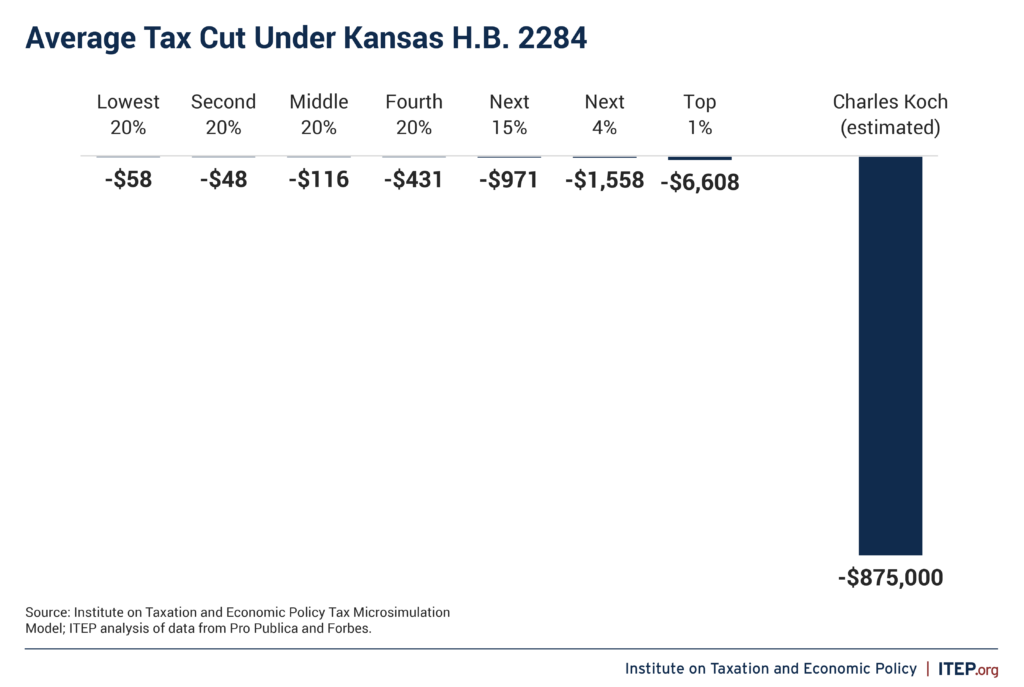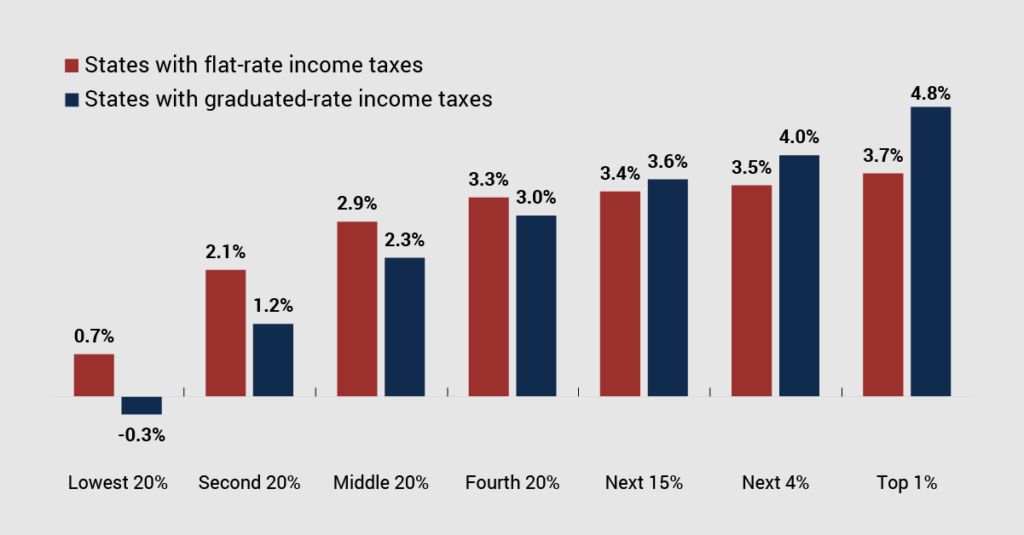Last week, both houses of the Kansas legislature approved a significant tax cut centered around replacing the state’s graduated rate income tax structure with a flat tax instead. The bulk of this would flow to upper-income families, mostly through lowering the state’s top income tax rate from 5.7 to 5.25 percent. This tax cut would be especially lucrative for the state’s wealthiest individual, billionaire Charles Koch. We estimate that Mr. Koch could expect to receive a tax cut in the neighborhood of $875,000 per year. As context, the median household income in Kansas is just shy of $70,000, meaning that Mr. Koch’s windfall would be the equivalent of more than 12 years’ worth of income for the typical Kansas household.
The figure below combines data from the ITEP Tax Microsimulation Model with an off-model analysis performed using data on Mr. Koch’s finances that were reported by Pro Publica and Forbes. According to the ITEP Model, the top 1 percent of earners in Kansas would see far larger tax cuts under this legislation than anyone among the bottom 99 percent of families. The $6,608 average tax cut going to top earners is 57 times larger than the average cut for middle-income earners and 114 times larger than the average cut for the state’s lowest-income residents. But some members of the top 1 percent, almost certainly including Mr. Koch, would receive tax cuts far larger than $6,608.
The ITEP Model analyzes tax impacts across the income scale for all state and local tax types. But the model’s ability to estimate effects at the extreme reaches of the economic scale, particularly at the state level, is limited by IRS restrictions on reporting of top earners’ incomes and deductions. Typically, the highest income group for which we report tax data is the top 1 percent of earners. Supplementing our model data with additional data on the nation’s wealthiest families allows us to offer a fuller picture of tax impacts than the model alone can provide.
Without access to Mr. Koch’s Kansas tax filings, it is not possible to compute his precise tax cut with certainty. But a reasonable estimate can be arrived at using federal tax return data reported by ProPublica.
That reporting indicated that Mr. Koch enjoyed an average federal adjusted gross income of $213 million dollars per year across the six-year period spanning 2013 to 2018, and average federal taxable income of approximately $141 million per year. Adjusting those figures to account for differences in state and federal definitions of taxable income, and growing them in line with recent increases in Mr. Koch’s wealth as reported by Forbes, leads us to conclude that his state taxable income is likely in the vicinity of $194 million today. For somebody with an income at that level, the tax bracket and exemption changes contained in the legislation that recently passed the Kansas legislature would provide a tax cut of roughly $875,000 per year.
Mr. Koch could also expect to receive additional sales and property tax cuts under the bill, but those would amount to little more than a rounding error relative to the far larger windfall he would receive from the top income tax rate reduction.
It bears noting that an $875,000 annual tax cut is more than 7,500 times larger than the $116 average tax cut that the middle 20 percent of earners could expect to receive under this legislation. Similar, it is more than 15,000 times larger than the $58 average tax cut that the state’s lowest earners could expect to receive.
Across the country, state revenue and budget outlooks are rapidly becoming less rosy than they have been during the last few years. As surpluses dwindle and some states begin to face shortfalls, the tradeoffs associated with deep tax cutting will become harder to ignore. Choosing to cut taxes for high-income families in Kansas will inevitably require the state to do less of something else instead, be it fewer teacher pay raises, less frequent infrastructure maintenance, or any number of other reductions in public services. Lawmakers should imagine what Kansas could do for its residents with $875,000 a year, and then ask a simple question: is that money better spent on helping our communities thrive, or lining the pockets of a single billionaire?





